Seafood Special
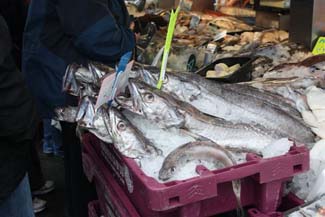 Once the summer begins to kick in the annual drift towards the seaside starts too, so fish and seafood soon take pride of place on menus and home dinner tables alike.
Once the summer begins to kick in the annual drift towards the seaside starts too, so fish and seafood soon take pride of place on menus and home dinner tables alike.
There are great goings-on in the world of seafood at the moment and, although the underlying reasons for a lot of the activity may be alarming – global warming, over fishing, depleted stocks of many species – it is heartening to see attention focused on finding solutions.
The Slow Fish campaign organised by the Slow Food movement has been working on the problem for many years through their awareness-raising biennial Slow Fish Fair in Genoa and many projects designed to support responsible artisanal fishing communities.
Similarly Euro-Toques International, the European chefs’ and cooks’ organisation dedicated to promoting local sourcing and protecting culinary heritage, is proactive in its support of responsible fishing.
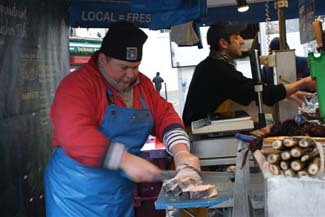 Together with members of the Alliance For Common Fisheries Policy Reform, Euro-Toques International organised a debate on the future of seafood supply with EU Commissioner for Fisheries and Maritime Affairs Maria Damanaki, on 25th April 2012 at the European Seafood Exposition, the world’s largest seafood trade event.
Together with members of the Alliance For Common Fisheries Policy Reform, Euro-Toques International organised a debate on the future of seafood supply with EU Commissioner for Fisheries and Maritime Affairs Maria Damanaki, on 25th April 2012 at the European Seafood Exposition, the world’s largest seafood trade event.
During the debate, the Alliance For Common Fisheries Policy Reform urged European decision-makers to address the current lack of governance by ending the short-term decisions that regulate fishing from year to year and by using EU funds effectively.
Speaking on behalf of the Alliance, Evan Doyle of Euro-Toques Ireland said: “Chefs don’t want fish to become a rare delicacy. The wild fish on our plates could disappear if the EU misses this year’s opportunity to reform the Common Fisheries Policy and put its fisheries on the road to recovery and sustainable management.” Furthermore he underlined the key roles that Chefs can play vis-à-vis consumers to help them choose the right fish when they are cooking at home or when they are in a restaurant.
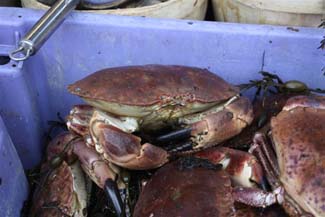 But it’s not only international organisations that can make a difference, and it’s especially encouraging to see how passionately committed individuals can make a real contribution. Here in Ireland, for example, Stephane Griesbach, of Gannet Fishmongers in Galway, has been toiling over a new website, which “is intended to be a comprehensive source of information about fish and the fish industry both for the public and for participants in the various aspects of the industry”.
But it’s not only international organisations that can make a difference, and it’s especially encouraging to see how passionately committed individuals can make a real contribution. Here in Ireland, for example, Stephane Griesbach, of Gannet Fishmongers in Galway, has been toiling over a new website, which “is intended to be a comprehensive source of information about fish and the fish industry both for the public and for participants in the various aspects of the industry”.
Although still a work in progress, this selfless task is already a remarkable achievement, listing nationwide sales outlets and providing an extraordinary range of detailed and educational information - as you can see in the introductions to the recipes below, which are inspired by the list of ‘Your Top 8 Fish’; Stephane starts it off somewhat mischievously with Wolf Fish, which is actually pretty rare, but it’s a great attention grabber!
As Stephane Griesbach points out, “Cod has become the benchmark of the fish world”. It has also become one of the world’s most controversial fish, and is widely regarded as an endangered species. However, Stephane points out that it is not endangered everywhere.
“Some areas in Europe have very healthy cod stocks while others are under serious pressure. Cod populations around Ireland are very low in the north Donegal area and in the Irish sea. However the stocks of cod in the Celtic sea, south of Ireland, are so healthy that the 2012 quota was increased by nearly 75%.”
So, although it may not always be easy to know exactly where it is coming from, the message is to “Eat more Cod, eat Cork's Cod" - and looking out for the Responsible Irish Fishing logo would be a good start.
Then there are the fishermen themselves, people like Frank Fleming of Responsible Irish Fish, who have worked tirelessly to introduce a label that guarantees high standards of handling and storage; quality; provenance; and responsibility.
The Responsible Irish Fish label assists vessel owners to achieve certification for their fish/shellfish, to develop a brand to allow Irish Fishermen differentiate their products in the market place and to promote Irish fish caught in a responsible manner - all aims which will benefit the fishing community and the consumer equally, making the label well worth seeking out.
A recent story that marks a very interesting development in the story of Irish fishing is from the fishing family Dorans of Howth, who have been in the seafood industry for over half a century but who sold the last of their fishing boats in the mid ‘90s.
After a gap of well over a decade, they’ve just bought the 18 metre Celtic Fisher, which will now supply not only their shop and wholesale customers, but also their two West Pier restaurants in Howth, The Oar House and Octopussy’s with Dublin Bay Prawns (langoustines) and ultra fresh fish. What’s more you can even order your fresh seafood while the Celtic Fisher is at sea and have it delivered to the door the day after landing: “Follow the Celtic Fisher on DoransHowth facebook page or on Twitter @Doransfishhowth …Followers will be able to track the vessel via AIS.COM. When informed of the landing time, log onto Doran’s home delivery website and place your order! Simple.” Simply amazing, actually.
RECIPES:
Some recipes are given on the new website, www.fishmongers.ie but the range so far is limited and they aren’t illustrated. So why not try some recipes from our cookbook, From Tide To Table - the selection ties in with some of Stephane Griesbach’s ‘Top 8 Fish’.
BLACK POLLOCK is listed third of ‘Top 8 Fish’ on Stephane Griesbach’s new website, www.fishmongers.ie – yet, he points out, “very few people will claim to have tried it despite that fact that almost everyone has eaten it in its smoked form, when sold as smoked coley”.
As for all the fish listed, he gives a lot of information: the Irish, Latin and common names; any similar fish; where it comes from; cuts available at the fresh fish counter; typical value (cheap, mid price, expensive – in this case ‘cheap’); sustainability and stock abundance (in this case, eat frequently; alternatives are eat in moderation; and over fished – enjoy as a once off).
Seasonality; eating qualities (texture, flavour, oily or not, bone content); recommended cooking methods; and complementary flavours are also given, to assist with saucing and accompaniments – an enormous amount of information on each fish, presented in neat, easily understood charts. And that is just from one small section of this extraordinarily informative website.
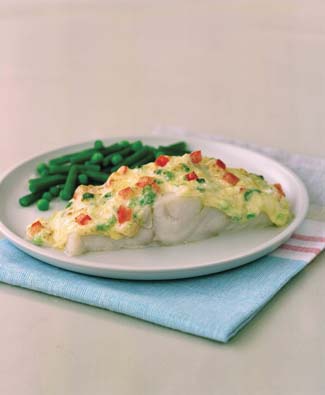 Cheesy-Grilled Pollock
Cheesy-Grilled Pollock
Pollock is cheap and plentiful so why not try it in this easy dish with a ‘cupboard standby’ topping that’s perfect for children and adults alike. The time it takes the fish will depend on the thickness of the fillet: it is important to cook it until just opaque and flaking.
To check that it is cooked, gently prod the thickest part of the fish with the point of a knife and the flakes should separate easily. Red Cheddar cheese may be used, if preferred, and will give a more deeply coloured topping.
Serves 4
2 ripe tomatoes
150g/5oz mature Cheddar cheese
4 spring onions, trimmed and finely chopped
4 tbsp mayonnaise
2 tbsp plain flour
4 x 150g/5oz pollock fillets, skinned and boned
sunflower oil, for greasing
knob unsalted butter
salt and freshly ground black pepper
To Serve: buttered green beans and peas
Cut the tomatoes in half and remove the seeds, then finely dice the flesh and place in a bowl. Finely dice the cheese and add to the bowl with the spring onions, then just bind with the mayonnaise. Season to taste.
Preheat the grill to high. Arrange the pollock fillets on a lightly oiled, sturdy baking sheet and season lightly, then grill for 4-6 minutes until almost tender. This will depend on the thickness of the fillet.
Quickly spread the mayonnaise mixture on top and flash under the grill for another 2 minutes or until the cheese is bubbling and golden. Arrange on warmed plates with the buttered green beans and peas to serve.
VARIATION: Other white fish such as haddock, cod, whiting or hake may be substituted.
HAKE: Hake is another fish that is abundant and well priced – and, as much of the Irish catch goes to Spain, where it is highly prized, where better to look for inspiration when cooking it.
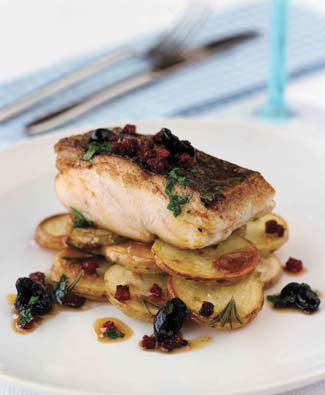 Crispy Hake with Chorizo and Black Olive Dressing
Crispy Hake with Chorizo and Black Olive Dressing
This hake dish is packed full of Mediterranean flavours, and needs nothing more to accompany it than a tasty potato side and a green salad – and maybe a well-chilled glass of crisp white wine. This recipe also works well with cod or haddock.
Serves 4
2 tbsp olive oil
4 x 175g/6oz hake fillets, skin on and boned
25g/1oz butter
100g/4oz raw chorizo, skinned and cubed
100g/4oz good quality black olives, stones removed
1 tbsp chopped fresh flat-leaf parsley
good squeeze of lemon juice
salt and freshly ground black pepper
Serving suggestion: crispy potato slices with rosemary & garlic
Heat half of the olive oil in a large heavy-based frying pan and add the hake fillets, skin side down. Cook for a minute or two until the skin is just beginning to crisp, then add little knobs of the butter to the pan around each piece of fish and continue to cook for another minute or so until the skin is nicely crisp.
Turn the hake fillets over and cook for a further 3-4 minutes until cooked through. This will depend on the thickness of the fillets. Transfer the cooked hake fillets to a warm plate and keep warm while you make the dressing.
Add the remaining tablespoon of olive oil to the frying pan and then tip in the chorizo. Sauté for 3-4 minutes until sizzling and the chorizo has just begun to release its oil. Remove from the heat and add the olives, parsley and lemon juice. Swirl the pan around until the dressing is nicely combined and season to taste.
Arrange piles of potato slices on warmed plates and top each one with a piece of hake, skin side up. Drizzle around the chorizo and black olive dressing to serve.






There are currently no comments
Leave a comment
Not a member? Register for your free membership now!
Or leave a comment by logging in with: